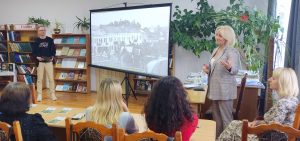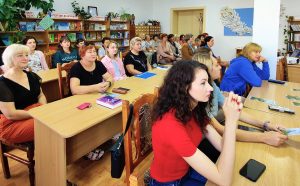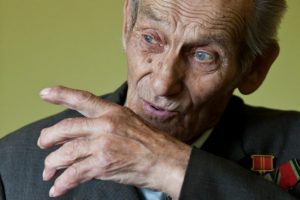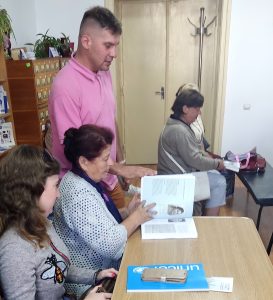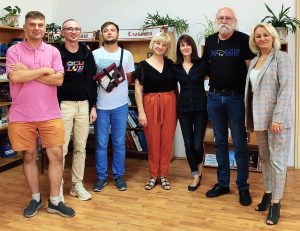This week Jay and I had the pleasure of joining friends and colleagues at an event hosted by the Rohatyn Central Library and attended by teachers, regional librarians, journalists, and other residents. The 2021 documentary film “Wordless” about the Holocaust in Turka (Lviv oblast) was screened, providing a starting point for event participants in a wide-ranging subsequent discussion about discrimination, prejudice, and intolerance, as well as totalitarian regimes, war, war crimes, and genocide.
![]() Ця сторінка також доступна українською.
Ця сторінка також доступна українською.
These topics were considered not only through the example of Holocaust as it was perpetrated in Turka, but also within the broader context of Russia’s current war in Ukraine and the Holocaust specifically in the city of Rohatyn and surrounding region more than 80 years ago. The challenges today are many, among them, how to develop an understanding of individual dignity, promote civil activism and advocacy for the voiceless and vulnerable, and maintain humanity even in the darkest of times.
The topics were brought into sharp focus for all present, as the event followed a sleepless night in western Ukraine due to numerous missile threats, while further east Russia bombarded multiple Ukrainian cities and towns through the evening and night, striking both military and civilian facilities.
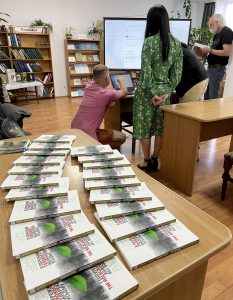
Free copies of the Jack Glotzer memoir available for participants. Photo © RJH.
The event grew out of an earlier exchange between Rohatyn librarian Lidiya Zhidachivska and Taras Grytsiuk, one of the coordinators of the German-Ukrainian program Connecting Memory focused on researching the Holocaust in Ukraine, protecting WWII mass graves of Jews and Roma, and engaging local Ukrainian communities in the preservation of cultural heritage and development of local initiatives; that exchange began during a visit we made to Rohatyn in June with Taras and others for a commemoration of the 80th anniversary of the liquidation of the Rohatyn Jewish ghetto. Over the past two and a half years our participation in the Connecting Memory program has significantly benefited Rohatyn Jewish Heritage through new and broader archival resources, the publication in print of a bilingual edition of Jack Glotzer’s memoir of Rohatyn “I Survived the Holocaust Against All Odds”, expert guidance on registration for legal protection of Jewish burial sites, reference data on design and costing of mass grave memorial monuments, and much more. Taras is also a leader of the Ukrainian NGO and professional community Insha Osvita (“Other Education”) which develops educational programs, works with culture and art as forms of collective learning, and creates mental and physical learning spaces. In the discussion in Rohatyn this week, Taras brought his deep knowledge of the Holocaust and its sociological impacts in Ukraine as well as his experience interacting with traumatized historians, heritage activists, and other culture workers since the Russian war of aggression intensified last year.
Turka is a medium-sized town southwest of Lviv near the border with Poland. Before WWII, Turka was demographically similar to Rohatyn, with roughly half the population Jewish, living both in the town center and less densely at the periphery. The USHMM Encyclopedia of Camps and Ghettos and other historical sources differ somewhat about the fate of these Jews following the German occupation in 1941, identifying some numbers concentrated in Turka and then deported to the ghetto in Sambir while others were sent more directly to the gas chambers at Bełżec. However, the French NGO Yahad – In Unum conducted on-site eyewitness interviews and other research in 2012 in order to document the killing processes as well as three sites of mass murder and burial in Turka, in the Jewish cemetery and at two more remote places in the hills outside of town. As in Rohatyn, very few of Turka’s roughly 3,000 Jews survived the killing, and none remained in the area after the war ended; in the following decades under the Soviet regime, local memory of the Jewish community faded.

Exhibition “Voices – A Mosaic of Ukrainian Jewish Life” co-curated by After Silence at the Jewish Museum in Augsburg, Germany.
The Ukrainian NGO After Silence was formed in 2021 to uncover past traumatic experiences related Soviet and Nazi violence which then became “officially ignored”, and in that silence degenerated into unrecognizable physical and mental landscapes, family misunderstandings, and unresolved pain. As noted on their website, the initiative uses memorial culture, public history, and social anthropology to develop a critical understanding of Ukraine’s past and present. The breadth of historical tragedy is unfortunately almost limitless, but a few intensive histories have been key in the NGO’s work to date, including the 1941~1944 Holocaust and the 1944~1953 deportations by the Soviet regime of “undesirables” to Siberia, the Far East, and Central Asia. Andrii Usach, co-founder of After Silence, highlights the difficulty of uncovering memory in a region with overlapping forms of physical and psychological violence: “For many, their own traumatic experiences push out of their memory everything related to other people’s tragedies. Hence the reluctance to talk about something other than what specifically hurts you.” But he adds, “The Holocaust is also non-Jewish history and non-Jewish memory.”

Two still images from the 2021 film “Wordless” by the NGO After Silence.

Video testimony recorded in Turka in 1992 by David Lee Preston,
as seen in the documentary film “Wordless”.
Working with the earlier research of Yahad – In Unum and with film footage made nearly 30 years earlier by David Lee Preston, a journalist and the son of a Holocaust survivor born in Turka, the After Silence documentary team of Usach, Anna Yatsenko, Anna Dorozhko, and Anna Malakhova first visited Turka in late 2020 to learn more through ten oral history interviews with eyewitnesses of the Holocaust events and those who heard of them from older relatives. The resulting short film, “Wordless”, was produced with support from the Connecting Memory program, has been screened at conferences and film festivals in Ukraine and abroad, and is available for free viewing on the After Silence website. In 2022, “Wordless” was also included in the online DOCU/CLUB film collection of the NGO Docudays UA, a human rights media education resource center which provides expert recommendations on organizing screenings, discussions and interactive events for different target audiences.
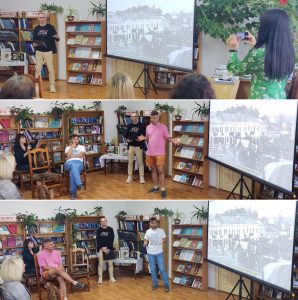
Andrii Volyk, Taras Grytsiuk, and Andrii Usach each leading portions of the group discussion. Photos © RJH.
Joining us in Rohatyn to moderate the discussion at the library before and after screening the film was Andrii Volyk, a journalist and educator of the NGO STAN in Ivano-Frankivsk, which aims to develop intercultural dialog and promote education on human dignity and civil society engagement; Andrii is also the regional coordinator for Docudays UA in the region. Following the screening, Andrii invited participants to give their impressions of the film and the conflicted situation that Holocaust witnesses found themselves in in post-war Soviet Turka. Andrii and Taras then opened an exchange with participants about the massacre site Babyn Yar in Kyiv, a national symbol of the Holocaust in Ukraine and often the dominant focus of Holocaust education here. The discussion then contrasted the smaller but very visible killings of Jewish neighbors in hundreds of places in today’s western Ukraine, such as Turka and Rohatyn, and the impact on local witnesses of those crimes.
This led to a broader discussion about Jewish heritage in Ukraine and non-Jewish memory of the Holocaust; participants were invited to share what they had seen and heard from older relatives and others about the events in Rohatyn, before, during, and after the German occupation. A variety of resources for further study were highlighted by the event organizers and by the librarians, including books in the library collection, the Rohatyn Jewish Heritage website, the Jack Glotzer memoir (which the central library has also distributed to the district village libraries), and a publication newly translated into Ukrainian, “Mass Shootings – The Holocaust from the Baltic to the Black Sea 1941-1943”, a copy of which was given by Taras to the Rohatyn Central Library and another to one of the local participants in the discussion. Like the Jack Glotzer memoir, this last publication was developed by Connecting Memory and its partner organizations the Foundation Memorial to the Murdered Jews of Europe in Berlin and the Ukrainian Center for Holocaust Studies in Kyiv, with financial support from the German Federal Foreign Office.
A final topic discussed by the group was on the origins of genocide and in particular a concept developed by the Anti-Defamation League, the “pyramid of hate”, in which biased behaviors evolve in complexity and severity as each level is gradually accepted in communities and societies. Participants were then invited to reflect on how aggression and the torture and killing of civilians in Russian-occupied regions of Ukraine in the current war grew from another instance of normalized prejudice.
On behalf of Rohatyn Jewish Heritage, Jay and I would like to thank our longtime friends at the Rohatyn Central Library for hosting today’s event, as well as Taras Grytsiuk, Andrii Usach, and Andrii Volyk for their thoughtful comments and guidance in the discussion around the film. We would especially like to thank all of the participants from Rohatyn and the local area for their interest and engagement with the topics. We look forward to other multicultural events at the library in the future.
(Update: During the week following the event, the local Rohatyn newspaper “Holos Opillya” published an extended article in Ukrainian with photos about the meeting at the library, the film, and the discussion. Click here to read the article.)

